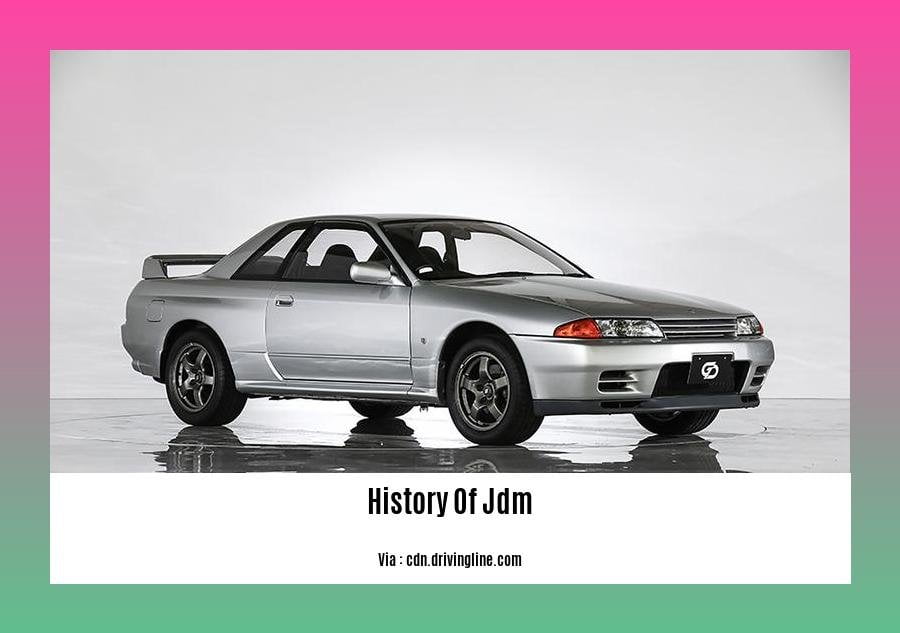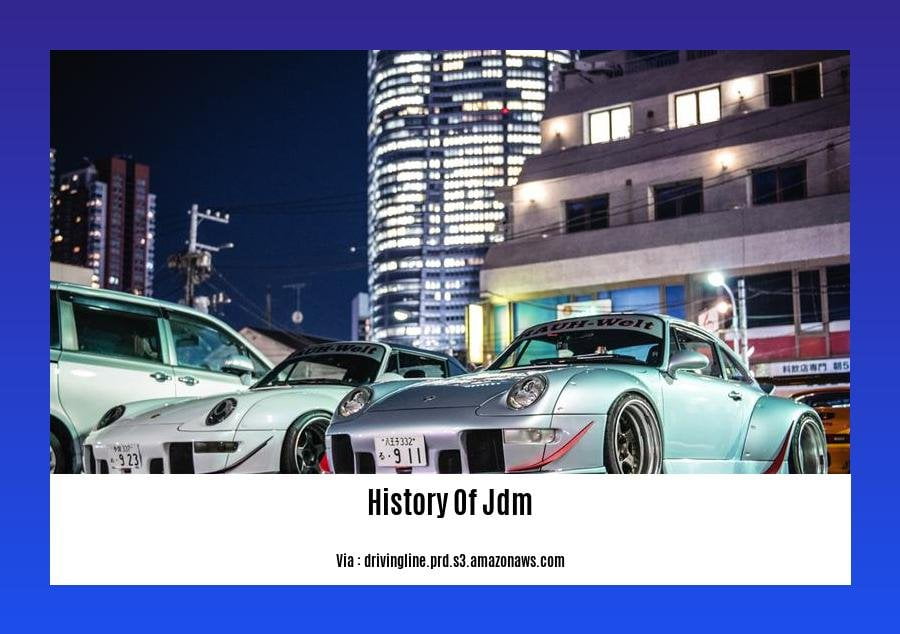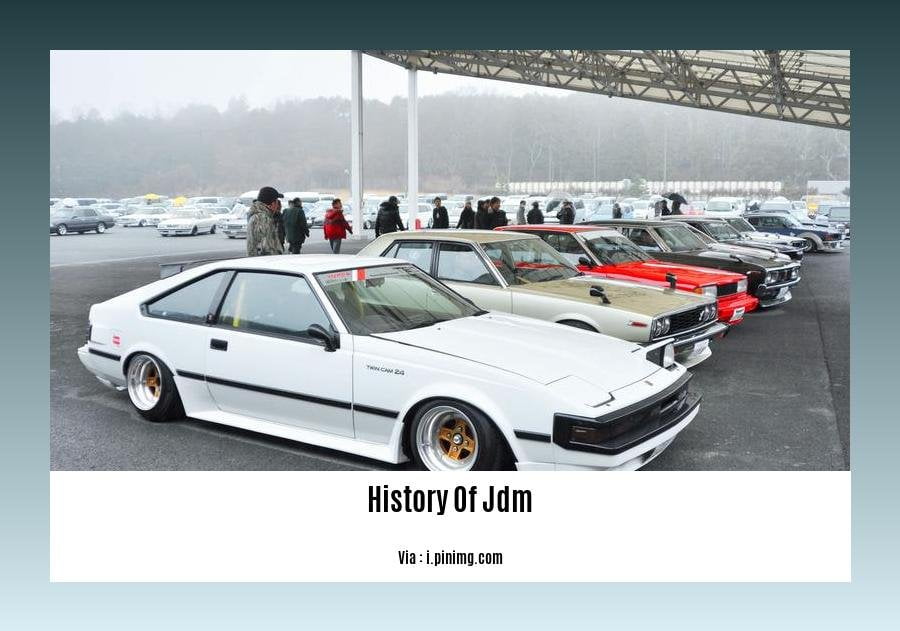Embark on a captivating journey through the annals of Japanese automotive excellence with our exploration entitled “[Journey Through the History of JDM: Unveiling the Essence of Japanese Automotive Excellence].” Delve into the rich tapestry of the Japanese Domestic Market (JDM), a realm where engineering prowess intertwines with cultural significance, shaping the very essence of what it means to be an automotive enthusiast. Prepare to be enthralled as we uncover the origins of JDM, tracing its evolution from humble beginnings to its current status as a global phenomenon.
Key Takeaways:
-
JDM car culture emerged in the ’60s and ’70s when Japanese automakers produced reliable, faster, and more efficient vehicles.
-
Initial popularity surged in the early 2000s with underglow, body kits, and exterior modifications.
-
Later evolved in the late 2000s to a “new era” emphasizing stancing, drifting, tuning, and show cars.
-
JDM cars have a global presence, particularly in countries with a strong car culture like the United States, known for unique styling, reliability, and performance.
-
Strict Japanese vehicle inspection regulations contribute to the excellent condition and longevity of JDM cars on the road.
History of JDM

Japanese Domestic Market (JDM) cars have a rich and vibrant history, deeply rooted in post-World War II Japan. Let’s delve into the evolution of JDM cars, exploring how they became iconic symbols of Japanese automotive excellence.
A Post-War Resurgence
The history of JDM begins in the 1960s and 1970s, a period of remarkable economic growth and technological innovation in Japan. This era witnessed the rise of legendary automakers like Toyota, Nissan, and Honda, who revolutionized the automotive industry with their reliable, fuel-efficient vehicles.
These cars, initially designed for the domestic market, quickly gained popularity for their superior engineering and affordability. Their success laid the foundation for the JDM phenomenon, setting the stage for the global recognition JDM cars would later achieve.
The JDM Wave: Rising Popularity and Cultural Influence
In the 1980s and 1990s, JDM cars gained international prominence, capturing the attention of car enthusiasts worldwide. The rise of tuner culture and the popularity of racing video games like Gran Turismo further fueled the JDM craze, propelling these cars into the global spotlight.
JDM cars became symbols of Japanese engineering prowess, renowned for their exceptional performance, distinctive styling, and advanced technology. Their popularity transcended borders, creating a global community of enthusiasts united by their shared passion for these unique vehicles.
JDM Today: A Legacy of Innovation and Excellence
In the 21st century, JDM cars continue to be highly sought after by collectors and enthusiasts. JDM culture has evolved, encompassing a diverse range of styles and modifications, from classic restorations to modern performance upgrades.
The enduring appeal of JDM cars lies in their unique blend of reliability, performance, and cultural significance. They represent the pinnacle of Japanese automotive engineering, a testament to the country’s rich history of innovation and excellence in car manufacturing.
History of Keyboard Instruments: Explore the fascinating journey of keyboard instruments, from their early origins to the modern marvels that grace concert halls and living rooms. Read more about the history of keyboard instruments here.
History of Kitesurfing: Catch the wind and ride the waves as you delve into the exhilarating history of kitesurfing. Discover how this thrilling sport evolved from humble beginnings to become a beloved pastime enjoyed by adventurers worldwide. Read more about the history of kitesurfing here.
History of Lacrosse Timeline: Witness the evolution of lacrosse, a Native American sport that has captivated generations with its fast-paced action and strategic finesse. Follow the sport’s journey through time, from its ancient roots to its modern-day status as a globally recognized競技. Read more about the history of lacrosse timeline here.
What Is The Origin Of Jdm Cars?

Japanese Domestic Market (JDM) cars are a cultural phenomenon in the global automotive landscape. Their unique styling, remarkable performance, and undeniable quality have captured the imagination of enthusiasts worldwide.
Ever wondered how this automotive subculture took root and what factors contributed to its immense popularity? Join us on a journey of discovery as we trace the lineage of JDM cars, exploring the circumstances that fueled their creation and the key players that shaped their evolution.
A Glimpse into JDM’s Roots: The Post-War Era
The story of JDM cars begins in the aftermath of World War II. Post-war Japan found itself in dire need of transportation solutions to rebuild its war-torn nation. This adversity became a catalyst for automotive innovation, as Japanese automakers rose to the challenge.
The Birth of JDM Cars: A Spirit of Innovation and Resilience
In the 1950s and 1960s, Japanese automakers began experimenting with new designs, technologies, and engineering solutions. This era marked the genesis of iconic JDM models like the Toyota Corolla and the Nissan Skyline, vehicles that would later achieve legendary status among enthusiasts.
The 1970s: A Turning Point for JDM Cars
The global oil crisis of the 1970s triggered a paradigm shift in the automotive industry. Japanese automakers rose to the challenge, creating fuel-efficient and reliable cars that met the demands of the time. These JDM cars quickly gained recognition for their superior quality and performance, establishing a solid reputation in both domestic and international markets.
The 1980s and Beyond: JDM Cars Become Global Icons
The 1980s witnessed the rise of JDM performance cars, epitomized by models like the Nissan Skyline GT-R, Toyota Supra, and Mazda RX-7. These vehicles not only dominated racetracks but also captured the hearts of car enthusiasts worldwide. With their aggressive styling and blistering performance, JDM cars became symbols of speed, agility, and precision.
The 1990s: The Golden Age of JDM Cars
The 1990s marked the pinnacle of JDM car culture. Japanese manufacturers produced some of the most iconic cars ever made, including the Honda NSX, the Mitsubishi Lancer Evolution, and the Subaru Impreza WRX. These vehicles showcased the pinnacle of Japanese engineering and design, solidifying JDM’s status as a global automotive powerhouse.
The 21st Century: JDM Cars Embrace Modernity
The 21st century ushered in a new era for JDM cars. Japanese automakers embraced advanced technologies, creating hybrids, electric vehicles, and hybrid-powered sports cars. These innovations demonstrated JDM’s commitment to sustainability and technological advancement.
Key Takeaways:
-
JDM cars originated in post-war Japan as a response to the nation’s need for reliable and affordable transportation.
-
The 1970s oil crisis led to the development of fuel-efficient and reliable JDM cars, solidifying their reputation for quality and performance.
-
The 1980s and 1990s marked the rise of iconic JDM performance cars, such as the Nissan Skyline GT-R and the Toyota Supra, which gained worldwide acclaim.
-
In the 21st century, JDM car makers embraced advanced technologies, creating innovative hybrids and electric vehicles while maintaining their commitment to performance.
[Sources]
-
Japanese Domestic Market Cars: A Comprehensive History
-
The Evolution of Japanese Domestic Market (JDM) Cars
When Did JDM First Start?
Throughout the decades, Japanese automobiles have gained global recognition and popularity. But when did it all begin? The journey of Japanese Domestic Market (JDM) cars is a captivating tale of innovation, performance, and cultural influence.
The Roots of JDM
The history of JDM can be traced back to the post-war era, when Japan embarked on a mission to rebuild its economy and infrastructure. The automotive industry played a crucial role in this reconstruction, and the Japanese government actively encouraged the production of reliable and affordable vehicles.
The 1960s: A New Era Begins
In the 1960s, Japan experienced a period of rapid economic growth, and the automotive industry flourished. This decade marked the birth of iconic JDM cars like the Toyota 2000GT and the Honda S800, which showcased the country’s engineering prowess and laid the foundation for future JDM legends.
The 1970s: Fuel Efficiency and Reliability Take Center Stage
The 1970s brought about the oil crisis, which had a profound impact on the global automotive landscape. Japanese automakers responded by developing fuel-efficient and reliable cars, which quickly gained popularity both domestically and internationally. This period saw the emergence of the Datsun 240Z and the Toyota Corolla, which became symbols of JDM excellence.
The 1980s and 1990s: The Golden Age of JDM
The 1980s and 1990s marked the golden age of JDM. This period witnessed the release of some of the most iconic Japanese performance cars, including the Nissan Skyline GT-R, the Toyota Supra, and the Mazda RX-7. These cars showcased the engineering prowess of Japanese automakers and captured the hearts of enthusiasts worldwide.
Key Takeaways:
-
JDM originated in the 1950s as a response to post-war Japan’s need for reliable and affordable transportation.
-
The 1970s oil crisis led to the development of fuel-efficient and reliable JDM cars, establishing their reputation for quality and performance.
-
The 1980s and 1990s marked the rise of iconic JDM performance cars, such as the Nissan Skyline GT-R and the Toyota Supra, which gained worldwide acclaim.
-
The 1990s marked JDM’s pinnacle, with iconic cars like the Honda NSX, Mitsubishi Lancer Evolution, and Subaru Impreza WRX solidifying JDM’s status as a global automotive powerhouse.
-
In the 21st century, JDM car makers embraced advanced technologies, creating innovative hybrids and electric vehicles while maintaining their commitment to performance.
Source:
Rev Your Engines: The Fascinating History of JDM Culture
JDM Engine Zone
FAQ
Q1. What are the origins of JDM culture?
A1. JDM culture traces its roots back to the 1960s and 1970s when Japanese automakers began producing reliable and high-performance vehicles for the domestic market.
Q2. What factors contributed to the initial surge in JDM popularity?
A2. The early 2000s witnessed a surge in JDM popularity characterized by modifications like underglow, body kits, and exterior enhancements.
Q3. How did the JDM scene evolve in the late 2000s?
A3. The late 2000s marked a shift in JDM trends, transitioning towards stancing, drifting, tuning, and showcasing cars at events like SEMA.
Q4. Why are JDM cars so popular globally?
A4. JDM cars are renowned worldwide for their unique styling, exceptional reliability, and impressive performance capabilities.
Q5. How does the Japanese Domestic Market (JDM) influence the condition of JDM cars?
A5. The strict vehicle inspection regulations in Japan ensure that JDM cars are meticulously maintained, contributing to their longevity and excellent condition.
















